2019 Lexus LC500 tow
[x] Cancel search: towPage 3 of 432
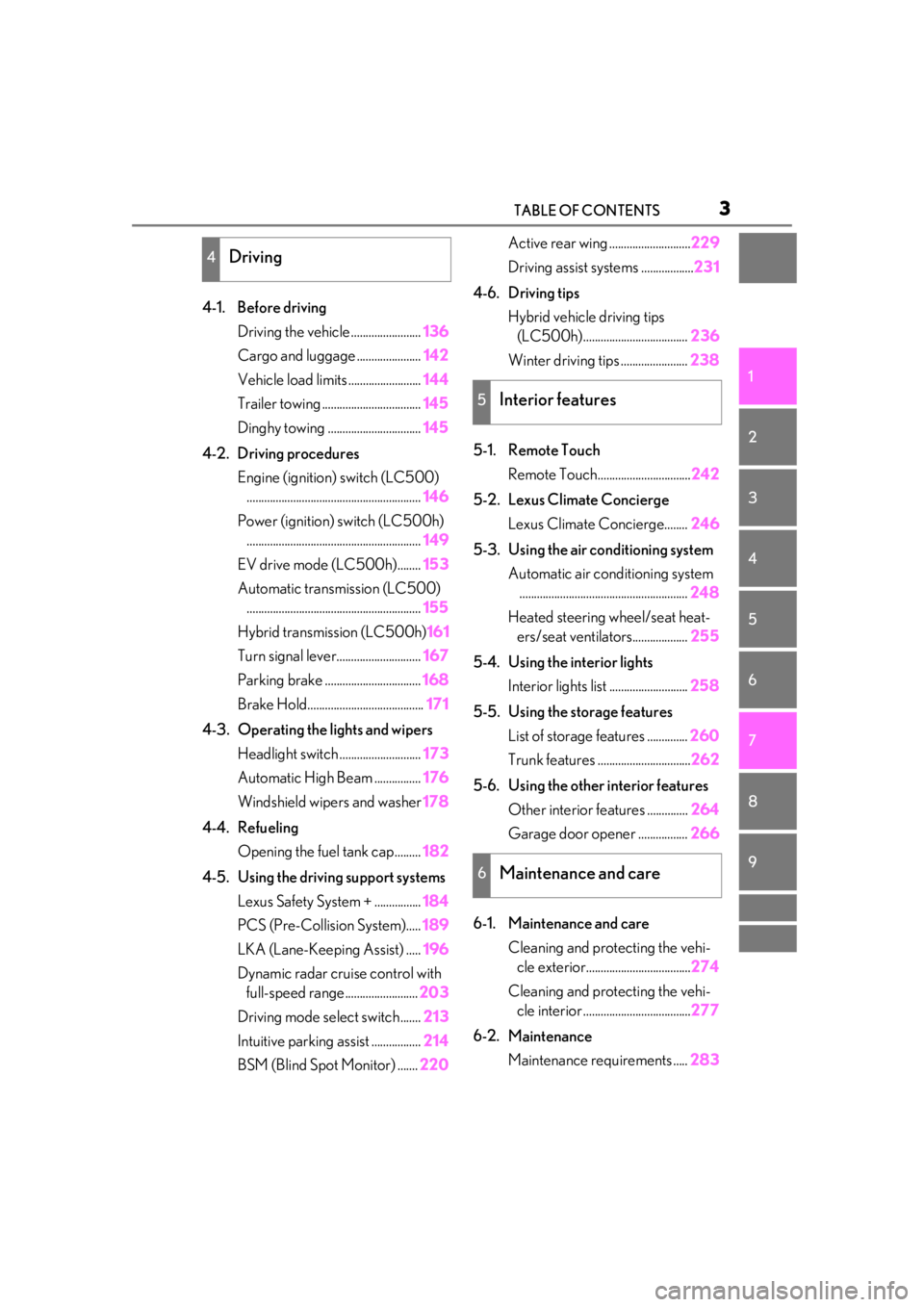
3TABLE OF CONTENTS
1
2
3
4
5
6
7
8
9
4-1. Before drivingDriving the vehicle ........................ 136
Cargo and luggage ...................... 142
Vehicle load limits ......................... 144
Trailer towing .................................. 145
Dinghy towing ................................ 145
4-2. Driving procedures Engine (ignition) switch (LC500)............................................................ 146
Power (ignition) switch (LC500h) ............................................................ 149
EV drive mode (LC500h)........ 153
Automatic transmission (LC500) ............................................................ 155
Hybrid transmission (LC500h) 161
Turn signal lever............................. 167
Parking brake ................................. 168
Brake Hold........................................ 171
4-3. Operating the lights and wipers Headlight switch ............................ 173
Automatic High Beam ................ 176
Windshield wipers and washer 178
4-4. Refueling Opening the fuel tank cap......... 182
4-5. Using the driving support systems Lexus Safety System + ................ 184
PCS (Pre-Collision System)..... 189
LKA (Lane-Keeping Assist) ..... 196
Dynamic radar crui se control with
full-speed range......................... 203
Driving mode select switch....... 213
Intuitive parking assist ................. 214
BSM (Blind Spot Monitor) ....... 220Active rear wing ............................
229
Driving assist systems .................. 231
4-6. Driving tips Hybrid vehicle driving tips (LC500h).................................... 236
Winter driving tips ....................... 238
5-1. Remote Touch Remote Touch................................ 242
5-2. Lexus Climate Concierge Lexus Climate Concierge........ 246
5-3. Using the air conditioning system Automatic air conditioning system.......................................................... 248
Heated steering wheel/seat heat- ers/seat ventilators................... 255
5-4. Using the interior lights Interior lights list ........................... 258
5-5. Using the storage features List of storage features .............. 260
Trunk features ................................ 262
5-6. Using the other interior features Other interior features .............. 264
Garage door opener ................. 266
6-1. Maintenance and care Cleaning and protecting the vehi-cle exterior.................................... 274
Cleaning and protecting the vehi- cle interior ..................................... 277
6-2. Ma
intenance
Maintenance re quirements .....283
4Driving
5Interior features
6Maintenance and care
Page 4 of 432
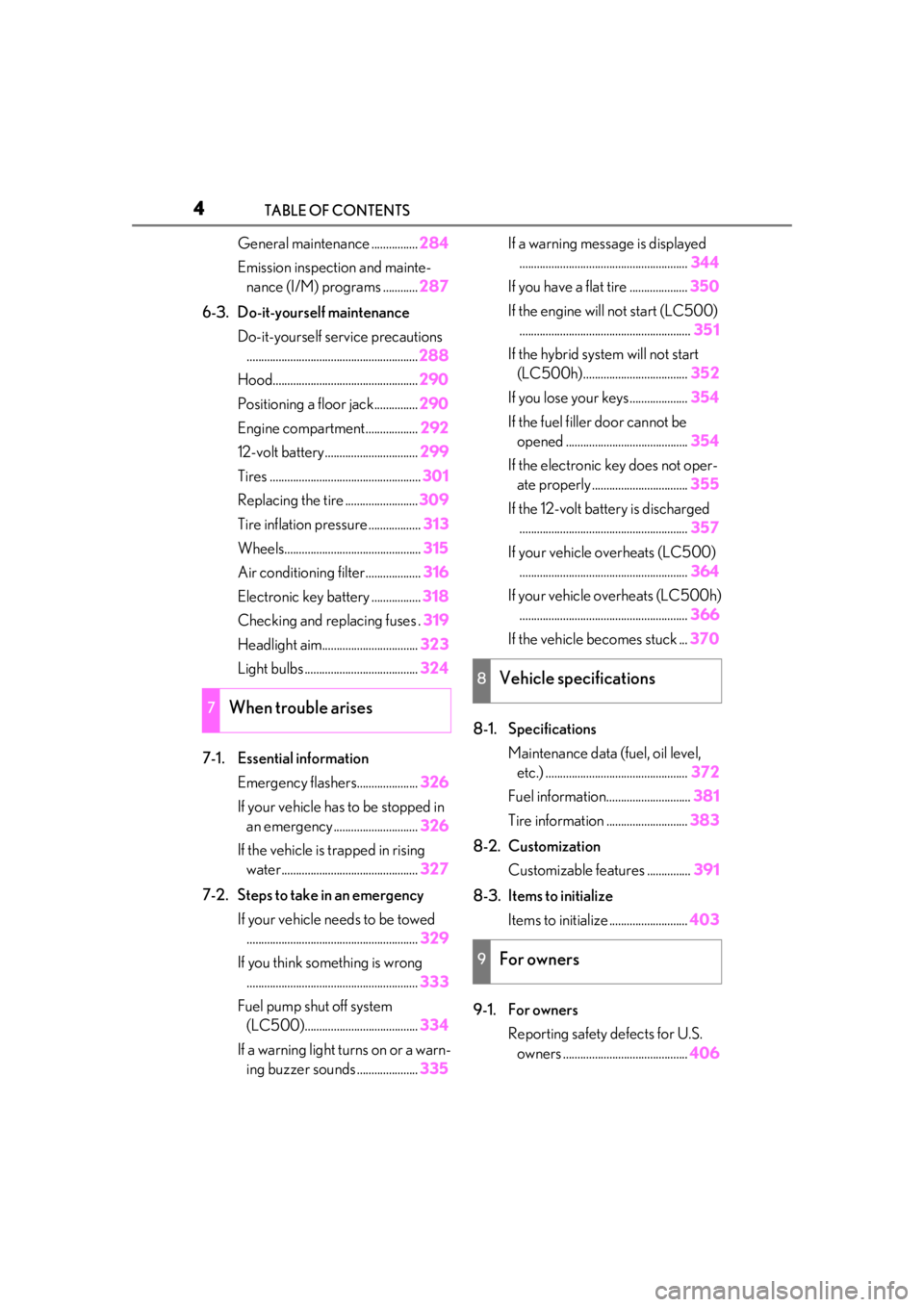
4TABLE OF CONTENTS
General maintenance ................284
Emission inspection and mainte- nance (I/M) programs ............ 287
6-3. Do-it-yourself maintenance Do-it-yourself service precautions........................................................... 288
Hood.................................................. 290
Positioning a floor jack............... 290
Engine compartment.................. 292
12-volt battery................................ 299
Tires .................................................... 301
Replacing the tire ......................... 309
Tire inflation pressure .................. 313
Wheels............................................... 315
Air conditioning filter...................316
Electronic key battery ................. 318
Checking and replacing fuses . 319
Headlight aim................................. 323
Light bulbs ....................................... 324
7-1. Essential information Emergency flashers..................... 326
If your vehicle has to be stopped in an emergency ............................. 326
If the vehicle is trapped in rising water............................................... 327
7-2. Steps to take in an emergency If your vehicle needs to be towed........................................................... 329
If you think something is wrong ........................................................... 333
Fuel pump shut off system (LC500)....................................... 334
If a warning light turns on or a warn- ing buzzer sounds ..................... 335If a warning messa
ge is displayed
.......................................................... 344
If you have a flat tire .................... 350
If the engine will not start (LC500) ........................................................... 351
If the hybrid syst em will not start
(LC500h).................................... 352
If you lose your keys.................... 354
If the fuel filler door cannot be opened .......................................... 354
If the electronic key does not oper- ate properly ................................. 355
If the 12-volt battery is discharged .......................................................... 357
If your vehicle overheats (LC500) .......................................................... 364
If your vehicle overheats (LC500h) .......................................................... 366
If the vehicle becomes stuck ... 370
8-1. Specifications Maintenance data (fuel, oil level, etc.) ................................................. 372
Fuel information............................. 381
Tire information ............................ 383
8-2. Customization Customizable features ............... 391
8-3. Items to initialize Items to
initialize ........................... 403
9-1. For owners Reporting safety defects for U.S. owners ........................................... 406
7When trouble arises
8Vehicle specifications
9For owners
Page 14 of 432
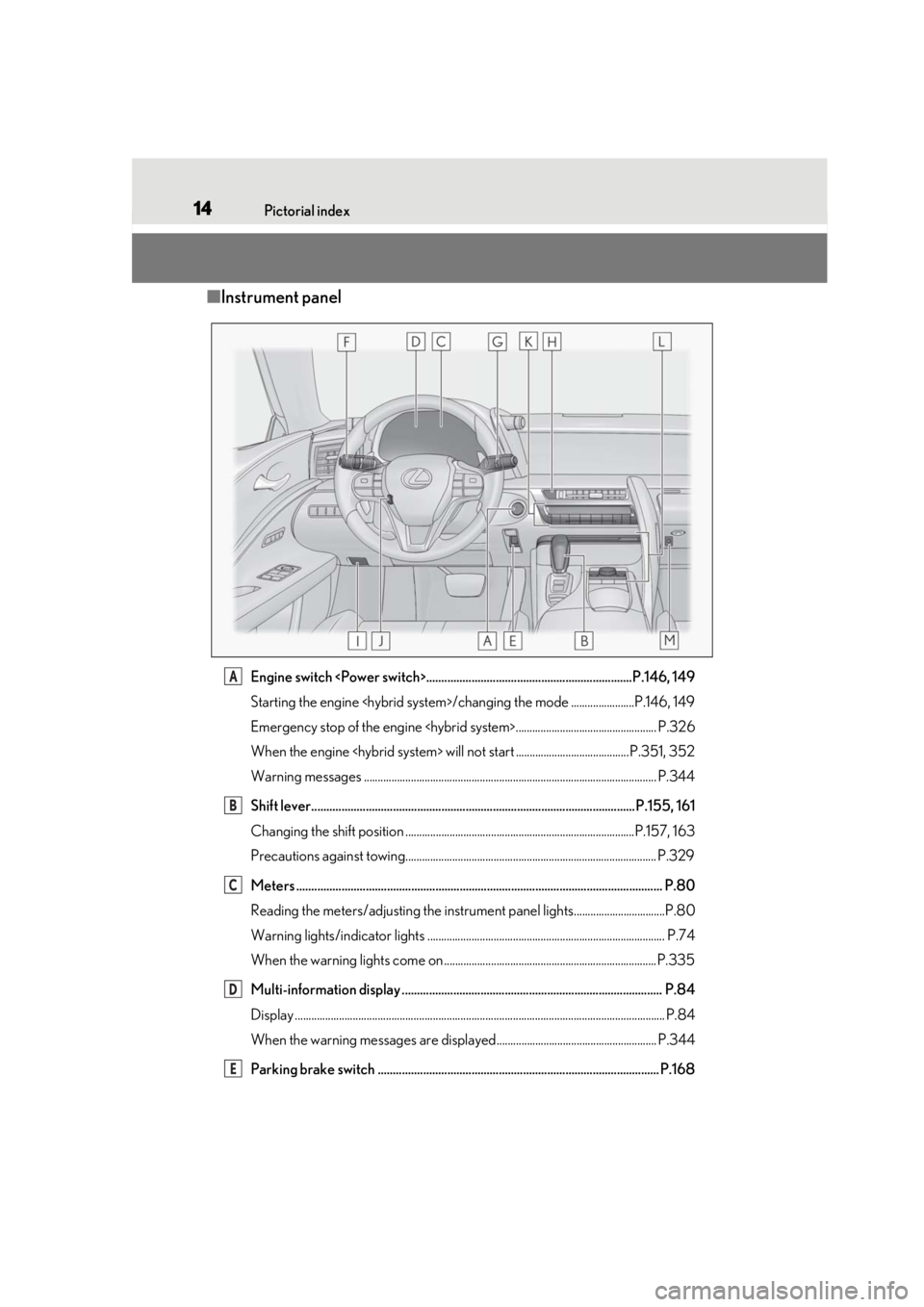
14Pictorial index
■Instrument panel
Engine switch
Starting the engine
Emergency stop of the engine
When the engine
Warning messages .......................................................................................................... P.344
Shift lever...........................................................................................................P.155, 16 1
Changing the shift position ...................................................................................P.157, 163
Precautions against towing........................................................................................... P.329
Meters ......................................................................................................................... P.80
Reading the meters/adjusting the instrume nt panel lights.................................P.80
Warning lights/indicator lights ...................................................................................... P.74
When the warning lights come on .............................................................................P.335
Multi-information display ...................................................................................... P.84
Display ........................................................................................................................ .............. P.84
When the warning messages are displayed.......................................................... P.344
Parking brake switch ............................................................................................. P.168A
B
C
D
E
Page 33 of 432
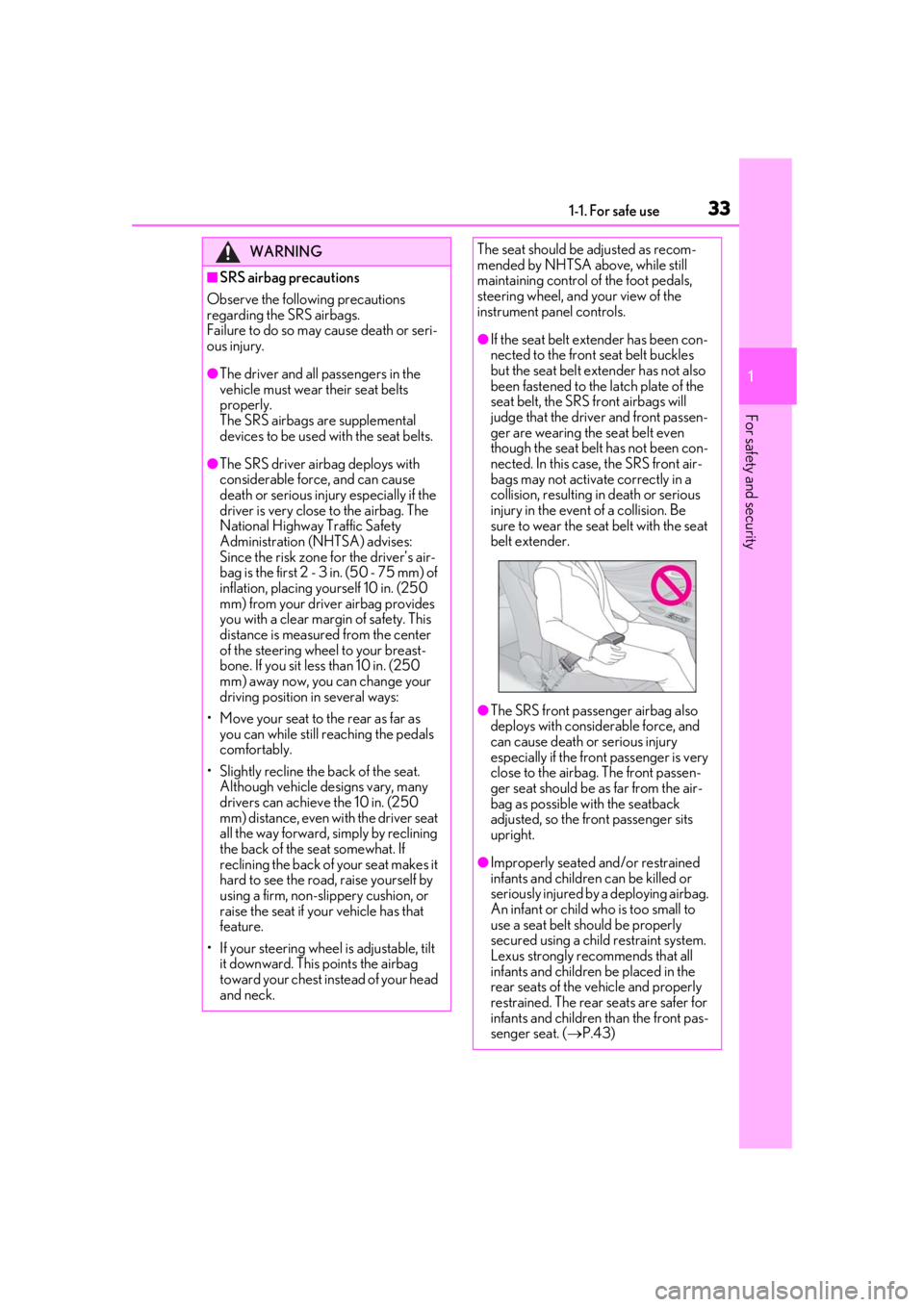
331-1. For safe use
1
For safety and security
WARNING
■SRS airbag precautions
Observe the following precautions
regarding the SRS airbags.
Failure to do so may cause death or seri-
ous injury.
●The driver and all passengers in the
vehicle must wear their seat belts
properly.
The SRS airbags are supplemental
devices to be used with the seat belts.
●The SRS driver airbag deploys with
considerable force, and can cause
death or serious injury especially if the
driver is very close to the airbag. The
National Highway Traffic Safety
Administration (NHTSA) advises:
Since the risk zone for the driver’s air-
bag is the first 2 - 3 in. (50 - 75 mm) of
inflation, placing yourself 10 in. (250
mm) from your driver airbag provides
you with a clear margin of safety. This
distance is measured from the center
of the steering wheel to your breast-
bone. If you sit less than 10 in. (250
mm) away now, you can change your
driving position in several ways:
• Move your seat to the rear as far as you can while still reaching the pedals
comfortably.
• Slightly recline the back of the seat. Although vehicle designs vary, many
drivers can achieve the 10 in. (250
mm) distance, even with the driver seat
all the way forward, simply by reclining
the back of the se at somewhat. If
reclining the back of your seat makes it
hard to see the road, raise yourself by
using a firm, non-slippery cushion, or
raise the seat if your vehicle has that
feature.
• If your steering wheel is adjustable, tilt it downward. This points the airbag
toward your chest instead of your head
and neck.
The seat should be adjusted as recom-
mended by NHTSA above, while still
maintaining control of the foot pedals,
steering wheel, and your view of the
instrument panel controls.
●If the seat belt extender has been con-
nected to the front seat belt buckles
but the seat belt extender has not also
been fastened to the latch plate of the
seat belt, the SRS front airbags will
judge that the driver and front passen-
ger are wearing the seat belt even
though the seat belt has not been con-
nected. In this case, the SRS front air-
bags may not activate correctly in a
collision, resulting in death or serious
injury in the event of a collision. Be
sure to wear the seat belt with the seat
belt extender.
●The SRS front passenger airbag also
deploys with considerable force, and
can cause death or serious injury
especially if the front passenger is very
close to the airbag. The front passen-
ger seat should be as far from the air-
bag as possible with the seatback
adjusted, so the front passenger sits
upright.
●Improperly seated and/or restrained
infants and children can be killed or
seriously injured by a deploying airbag.
An infant or child who is too small to
use a seat belt should be properly
secured using a child restraint system.
Lexus strongly recommends that all
infants and children be placed in the
rear seats of the vehicle and properly
restrained. The rear seats are safer for
infants and children than the front pas-
senger seat. ( P.43)
Page 34 of 432
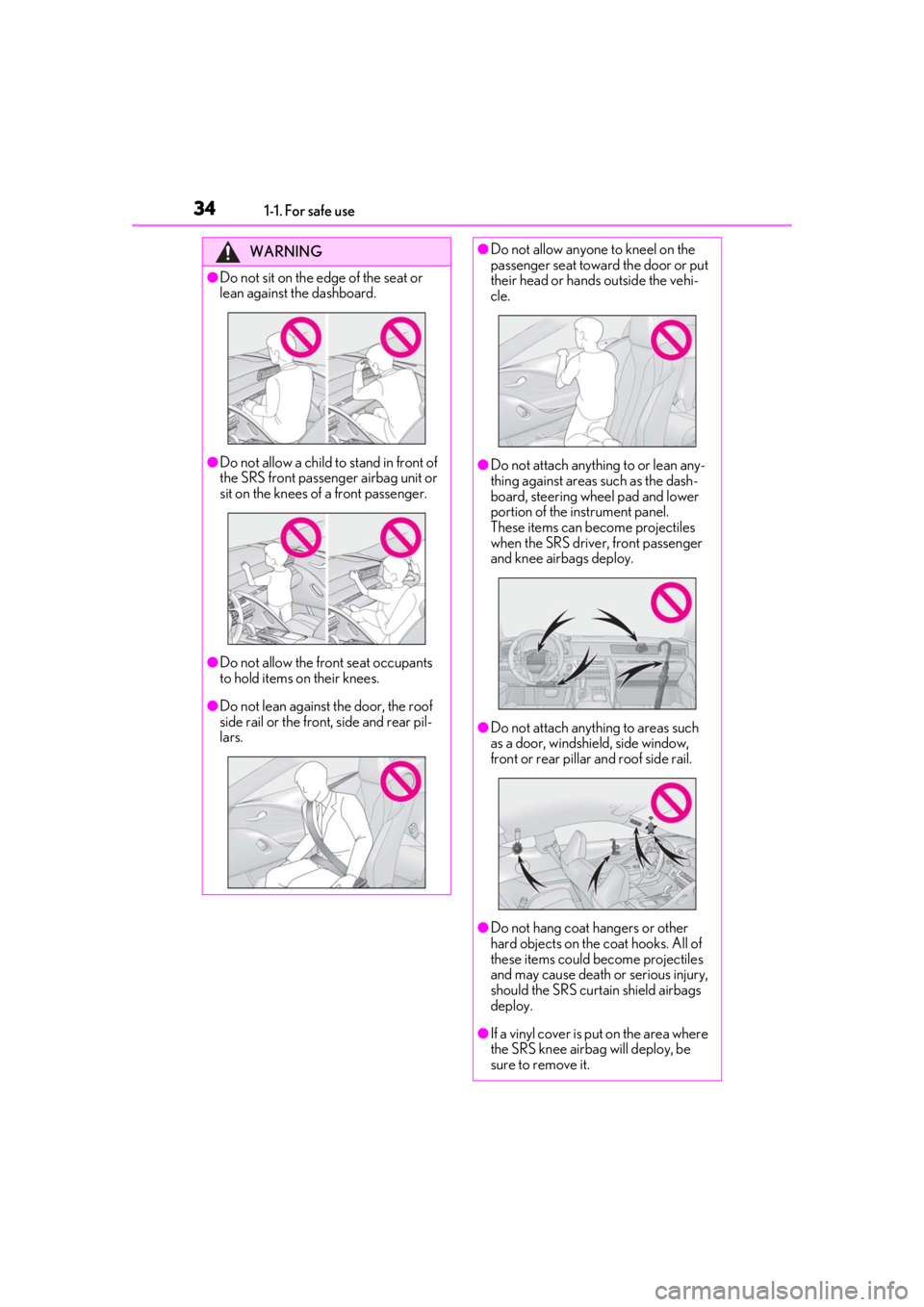
341-1. For safe use
WARNING
●Do not sit on the edge of the seat or
lean against the dashboard.
●Do not allow a child to stand in front of
the SRS front passenger airbag unit or
sit on the knees of a front passenger.
●Do not allow the front seat occupants
to hold items on their knees.
●Do not lean against the door, the roof
side rail or the front, side and rear pil-
lars.
●Do not allow anyone to kneel on the
passenger seat toward the door or put
their head or hands outside the vehi-
cle.
●Do not attach anything to or lean any-
thing against areas such as the dash-
board, steering wheel pad and lower
portion of the instrument panel.
These items can become projectiles
when the SRS driver, front passenger
and knee airbags deploy.
●Do not attach anything to areas such
as a door, windshield, side window,
front or rear pillar and roof side rail.
●Do not hang coat hangers or other
hard objects on the coat hooks. All of
these items could become projectiles
and may cause death or serious injury,
should the SRS curtain shield airbags
deploy.
●If a vinyl cover is put on the area where
the SRS knee airbag will deploy, be
sure to remove it.
Page 50 of 432
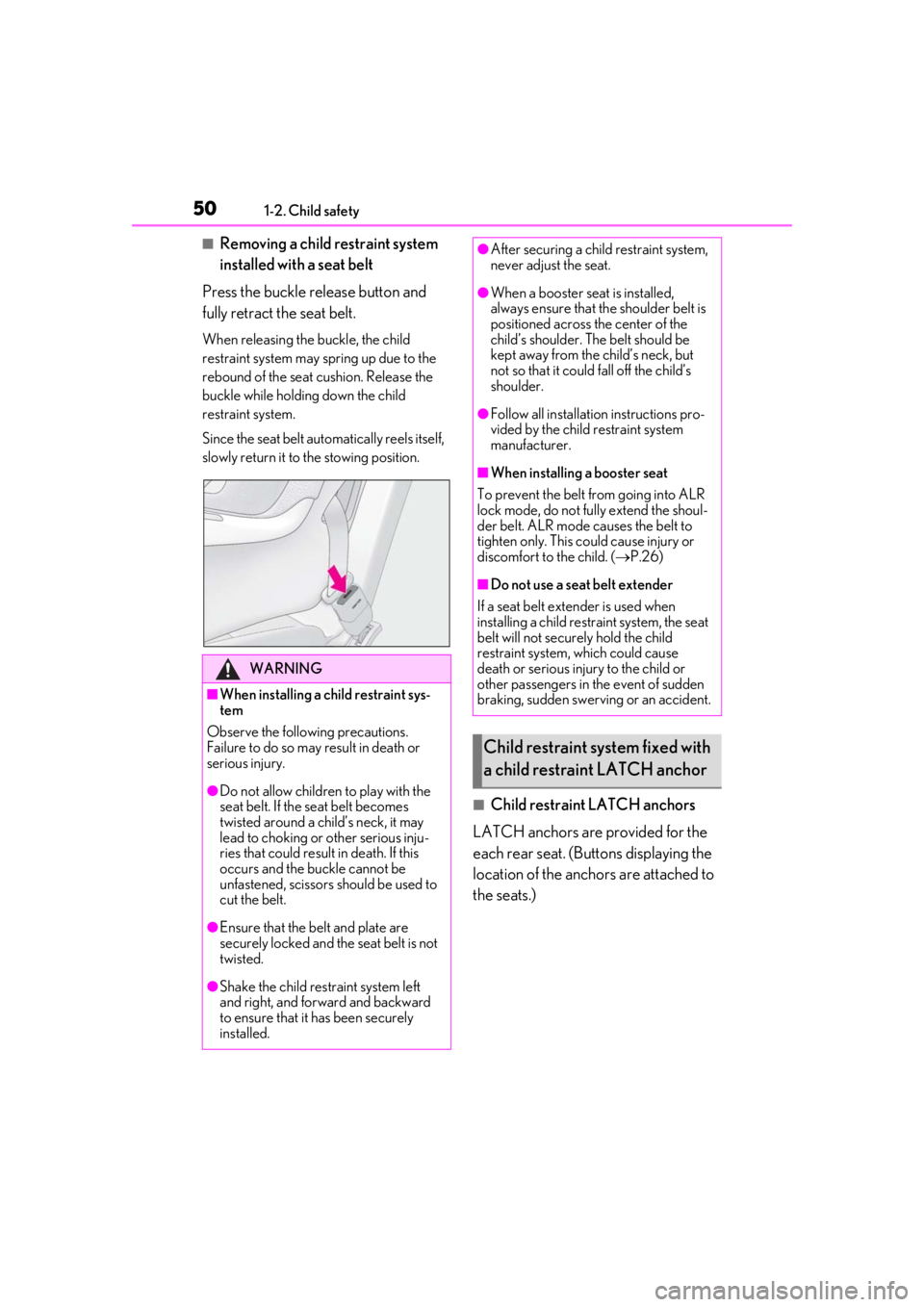
501-2. Child safety
■Removing a child restraint system
installed with a seat belt
Press the buckle release button and
fully retract the seat belt.
When releasing the buckle, the child
restraint system may spring up due to the
rebound of the seat cushion. Release the
buckle while holding down the child
restraint system.
Since the seat belt automatically reels itself,
slowly return it to the stowing position.
■Child restraint LATCH anchors
LATCH anchors are provided for the
each rear seat. (Buttons displaying the
location of the anchors are attached to
the seats.)
WARNING
■When installing a child restraint sys-
tem
Observe the following precautions.
Failure to do so may result in death or
serious injury.
●Do not allow children to play with the
seat belt. If the seat belt becomes
twisted around a child’s neck, it may
lead to choking or other serious inju-
ries that could result in death. If this
occurs and the buckle cannot be
unfastened, scissors should be used to
cut the belt.
●Ensure that the belt and plate are
securely locked and the seat belt is not
twisted.
●Shake the child restraint system left
and right, and forward and backward
to ensure that it has been securely
installed.
●After securing a child restraint system,
never adjust the seat.
●When a booster seat is installed,
always ensure that th e shoulder belt is
positioned across the center of the
child’s shoulder. The belt should be
kept away from the child’s neck, but
not so that it could fall off the child’s
shoulder.
●Follow all installation instructions pro-
vided by the child restraint system
manufacturer.
■When installing a booster seat
To prevent the belt from going into ALR
lock mode, do not fully extend the shoul-
der belt. ALR mode causes the belt to
tighten only. This could cause injury or
discomfort to the child. ( P.26)
■Do not use a seat belt extender
If a seat belt extender is used when
installing a child restra int system, the seat
belt will not securely hold the child
restraint system, which could cause
death or serious injury to the child or
other passengers in the event of sudden
braking, sudden swerving or an accident.
Child restraint system fixed with
a child restraint LATCH anchor
Page 57 of 432
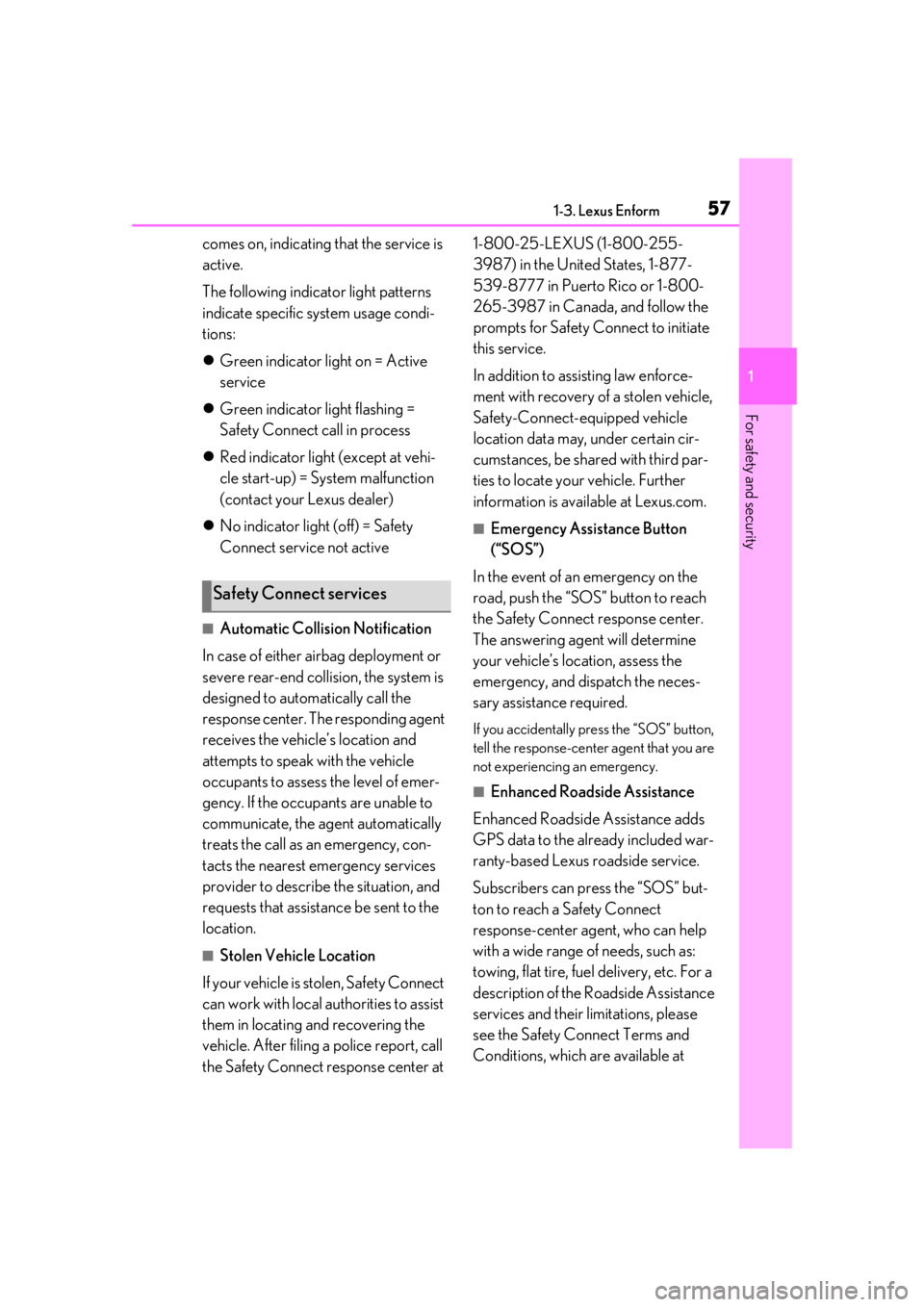
571-3. Lexus Enform
1
For safety and security
comes on, indicating that the service is
active.
The following indicator light patterns
indicate specific system usage condi-
tions:
Green indicator light on = Active
service
Green indicator light flashing =
Safety Connect call in process
Red indicator light (except at vehi-
cle start-up) = System malfunction
(contact your Lexus dealer)
No indicator light (off) = Safety
Connect service not active
■Automatic Collision Notification
In case of either airbag deployment or
severe rear-end collision, the system is
designed to automatically call the
response center. The responding agent
receives the vehicle’s location and
attempts to speak with the vehicle
occupants to assess the level of emer-
gency. If the occupants are unable to
communicate, the ag ent automatically
treats the call as an emergency, con-
tacts the nearest emergency services
provider to describe the situation, and
requests that assistance be sent to the
location.
■Stolen Vehicle Location
If your vehicle is stolen, Safety Connect
can work with local authorities to assist
them in locating and recovering the
vehicle. After filing a police report, call
the Safety Connect response center at 1-800-25-LEXUS (1-800-255-
3987) in the United States, 1-877-
539-8777 in Puerto Rico or 1-800-
265-3987 in Canada, and follow the
prompts for Safety Connect to initiate
this service.
In addition to assisting law enforce-
ment with recovery of a stolen vehicle,
Safety-Connect-equipped vehicle
location data may, under certain cir-
cumstances, be shared with third par-
ties to locate your vehicle. Further
information is available at Lexus.com.
■Emergency Assistance Button
(“SOS”)
In the event of an emergency on the
road, push the “SOS” button to reach
the Safety Connect response center.
The answering agent will determine
your vehicle’s location, assess the
emergency, and dispatch the neces-
sary assistance required.
If you accidentally press the “SOS” button,
tell the response-center agent that you are
not experiencing an emergency.
■Enhanced Roadside Assistance
Enhanced Roadside Assistance adds
GPS data to the already included war-
ranty-based Lexus roadside service.
Subscribers can press the “SOS” but-
ton to reach a Safety Connect
response-center agent, who can help
with a wide range of needs, such as:
towing, flat tire, fuel delivery, etc. For a
description of the Roadside Assistance
services and their limitations, please
see the Safety Connect Terms and
Conditions, which are available at
Safety Connect services
Page 66 of 432
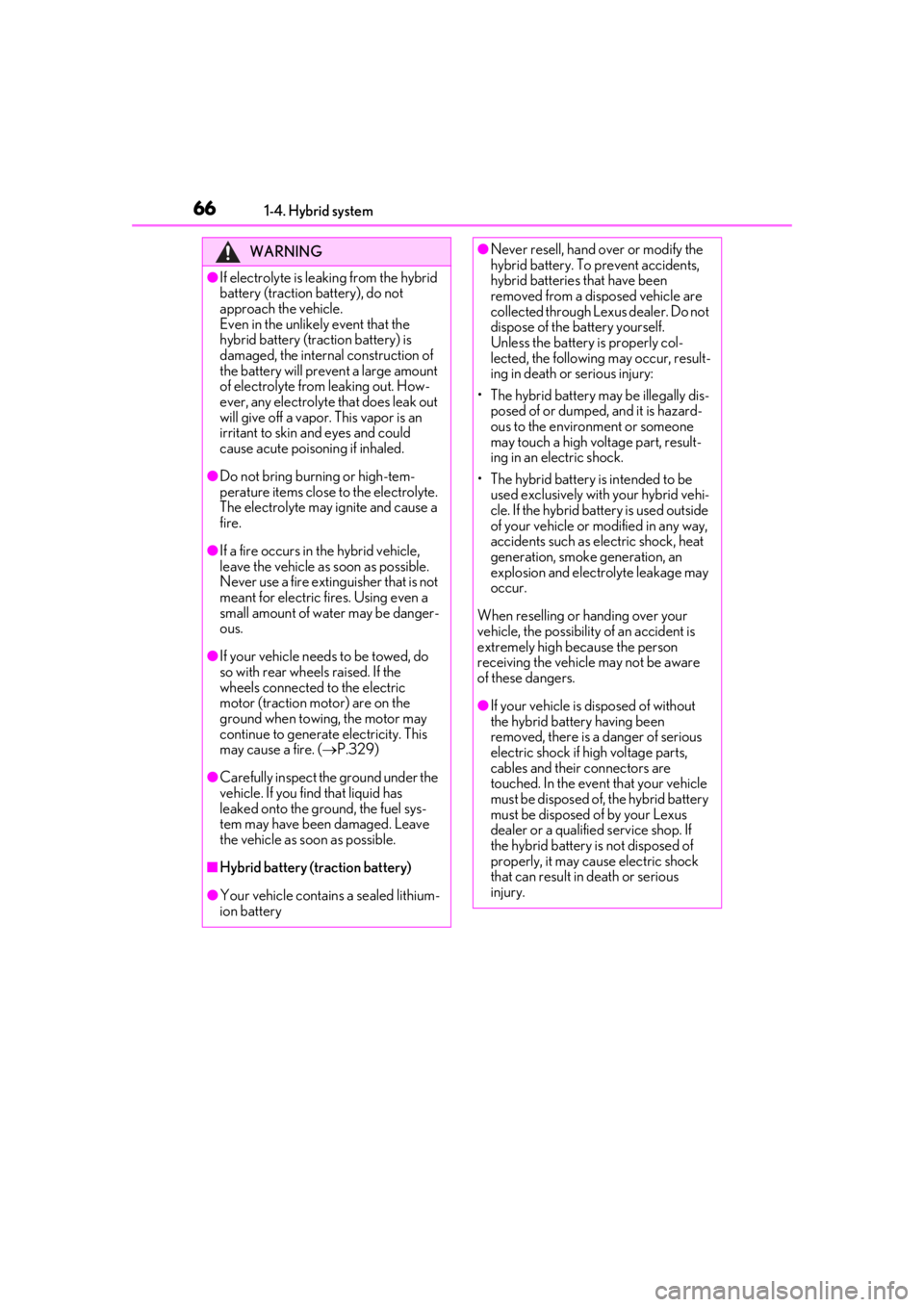
661-4. Hybrid system
WARNING
●If electrolyte is leaking from the hybrid
battery (traction battery), do not
approach the vehicle.
Even in the unlikely event that the
hybrid battery (traction battery) is
damaged, the internal construction of
the battery will prevent a large amount
of electrolyte from leaking out. How-
ever, any electrolyte that does leak out
will give off a vapor. This vapor is an
irritant to skin and eyes and could
cause acute poisoning if inhaled.
●Do not bring burning or high-tem-
perature items close to the electrolyte.
The electrolyte may ignite and cause a
fire.
●If a fire occurs in the hybrid vehicle,
leave the vehicle as soon as possible.
Never use a fire extinguisher that is not
meant for electric fires. Using even a
small amount of water may be danger-
ous.
●If your vehicle needs to be towed, do
so with rear wheels raised. If the
wheels connected to the electric
motor (traction motor) are on the
ground when towing, the motor may
continue to generate electricity. This
may cause a fire. ( P.329)
●Carefully inspect the ground under the
vehicle. If you find that liquid has
leaked onto the ground, the fuel sys-
tem may have been damaged. Leave
the vehicle as soon as possible.
■Hybrid battery (traction battery)
●Your vehicle contains a sealed lithium-
ion battery
●Never resell, hand over or modify the
hybrid battery. To prevent accidents,
hybrid batteries that have been
removed from a disposed vehicle are
collected through Lexus dealer. Do not
dispose of the battery yourself.
Unless the battery is properly col-
lected, the following may occur, result-
ing in death or serious injury:
• The hybrid battery may be illegally dis- posed of or dumped, and it is hazard-
ous to the environment or someone
may touch a high voltage part, result-
ing in an electric shock.
• The hybrid battery is intended to be used exclusively with your hybrid vehi-
cle. If the hybrid battery is used outside
of your vehicle or modified in any way,
accidents such as electric shock, heat
generation, smoke generation, an
explosion and electrolyte leakage may
occur.
When reselling or handing over your
vehicle, the possibility of an accident is
extremely high because the person
receiving the vehicle may not be aware
of these dangers.
●If your vehicle is disposed of without
the hybrid battery having been
removed, there is a danger of serious
electric shock if hi gh voltage parts,
cables and their connectors are
touched. In the event that your vehicle
must be disposed of, the hybrid battery
must be disposed of by your Lexus
dealer or a qualified service shop. If
the hybrid battery is not disposed of
properly, it may cause electric shock
that can result in death or serious
injury.